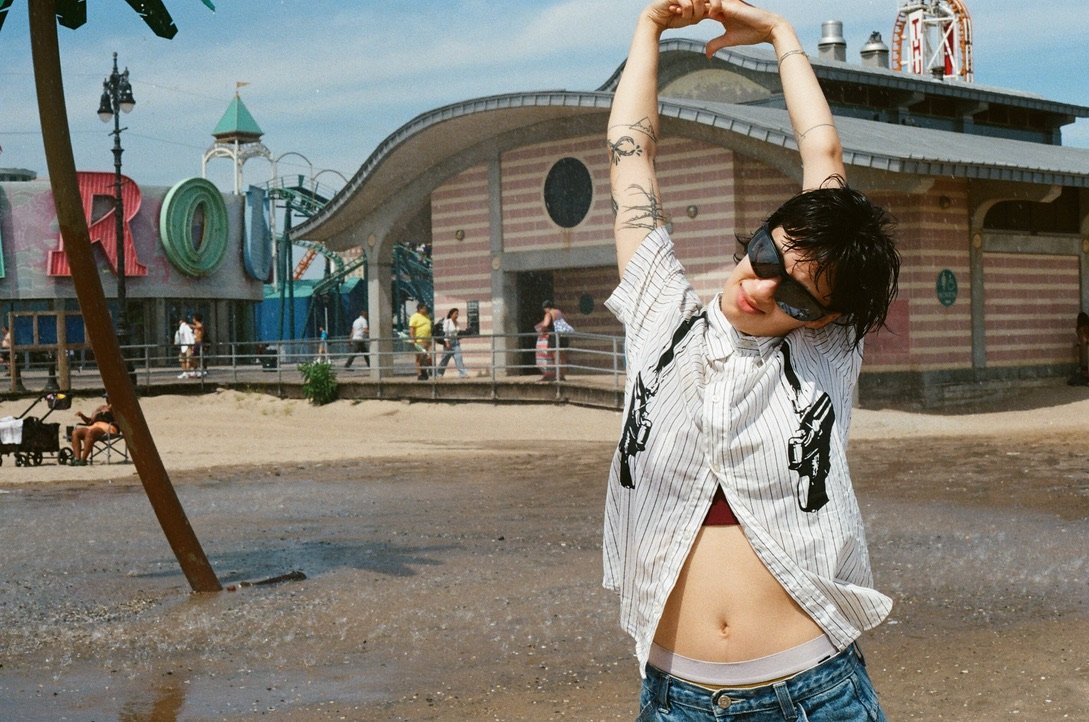
Boston-born and now New-York-City-based, the sonically innovative pop-rock unit Raavi has made constant reinvention the common thread across their prolific five-plus years of making music together. Led by singer-songwriter and guitarist Raavi Sita, the quartet’s releases trace a progression between fresh processes and daring stylistic pivots. Their work is constantly in dialogue with the music communities surrounding them, initially reflecting Sita’s musical upbringing at indie house shows. The massive guitars and emo-adjacent catharsis that runs through the band’s previous discography—from their 2018 debut EP i miss you already to their 2019 debut album Don’t Hit Me Up to their EPs and singles of the 2020s—points back to their DIY roots. However, Sita’s clear melodicism and disciplined songforms have always also been shaded by the influence of vintage singer-songwriters. The band’s new release, the The Upside EP, overlaps with the latter tradition more directly than anything they have done before. With fewer plugged-in sounds, it marks a left turn from the guitar-rock edifices that Raavi fans are used to. However, Sita’s candid and restrained songwriting on The Upside makes it an essential listen for both devotees and newcomers.
Sita admits that she reveres folk-influenced ‘70s stalwarts like Nick Drake, Joni Mitchell, and other modern acolytes of that tradition, but emphasizes that she never considers points of specific reference while formulating songs. Mostly she derives inspiration from her environment. In the case of the songs on The Upside, these locations were mostly places of repose and reflection. Writing in Spain (“The Exchange”), Pakistan (“Henry”), and elsewhere meant that the particular instruments she was traveling with also shaped the details of the music. There was the beloved acoustic guitar that she played late at night to avoid waking her NYC roommate, or the guitalele (sized between a guitar and ukulele) that accompanied her on trips to visit her father in Pakistan. For Raavi, these guitars allowed her to write differently than ever before, especially the guitalele, which accommodates faster and more complicated melodic and chordal patterns without being hard on the fingers.
Despite these similarities in process, the songs on The Upside were written over the course of a few years and capture very different mini-eras in Sita’s life. They examine formative romantic experiences, gender awakening, and disillusionment. With its notes of ‘70s Laurel Canyon singer-songwriters and folk iconoclasts The Roches, opener “Henry” explores a heavy topic against a breezy musical backdrop: childhood revelations about sexuality and identity. The eponymous character seems to stand in for men, or maleness as a construct, and the suffocating role it played in Sita’s middle school experiences. “I grew up androgynous, able to act like a chameleon to fit in with my male and female friends,” she explains. “It gave me [the] freedom to exist in both gendered worlds to some degree. At some point this reality came crashing down on me.”
The bulk of the rest of The Upside traverses similar territory—self-definition, self-protection, and coming-of-age—using a widened sonic palette. “Take Me” draws from high school experiences with intimacy, its emotional rawness enhanced by claptrap electronic sounds that blend with the acoustic, unvarnished sound of the band. Meanwhile, The oldest song on the EP, “Shadows,” catapults forward in time, describing disillusionment with the gender dynamics within music scenes that Raavi honed their sound within. (“I know I’m playing on a hunting ground,” Sita sings.) The song’s arrangement reflects the band’s penchant for studio experimentation. Hypnotic, interlocking guitars merge with glitchy effects, hanging on a chord progression that never resolves. The song’s coda disappears somewhere beyond the horizon, as if signaling that the narrator will have to continue to grapple with her feelings of alienation.
Most importantly, perhaps, these songs showcase a daring new formal sensibility in Sita’s writing. The compositions on The Upside feature poetic musical structures that all avoid using a repeated chorus. Songs that move in this unconventional way lend themselves to stripped-down production which makes it easier for the audience to follow along with the lyrics and harmonic twists and turns, and lock in with subject matter.
The experiences Sita describes on The Upside may be upsetting, but the songs represent a triumph over adversity—tentative moves toward solidifying a fuller identity. In these stark musical settings, Sita writes from a place of narrative and musical strength, her view of events enhanced by the gift of hindsight. Fans shouldn’t expect Raavi’s releases—a full-length is on the way in the not-so-distant future—to continue to pursue this unadorned musical territory. However, listeners will immediately appreciate how singular and potent this mini-collection of material feels within Raavi’s catalog, as well as within their corner of the New York City scene—a rare gem that necessitates close relistening and profound consideration.
